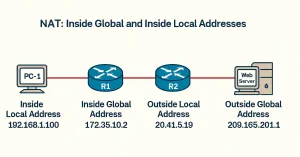NAT Terminology Explained: CCNA 200-301 Must-Know Address Types
As discussed before, NAT translates private IP addresses into public IP addresses. So in the process of translation, there are different operations involved, and understanding each of them requires understanding NAT terminology. Therefore, before understanding NAT in detail, it is important to understand basic NAT terminology. In NAT terminology, the inside network is the set […]

